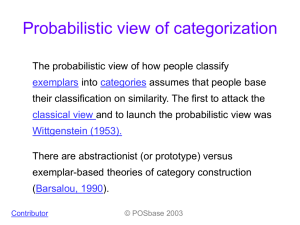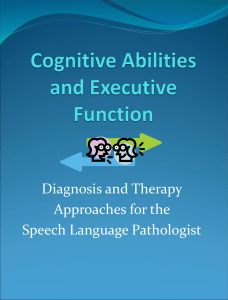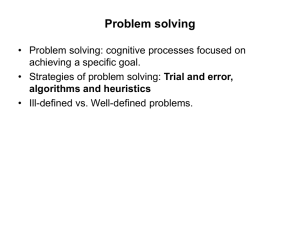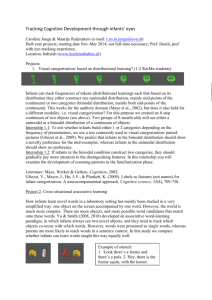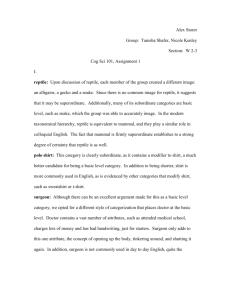Academic Interventions
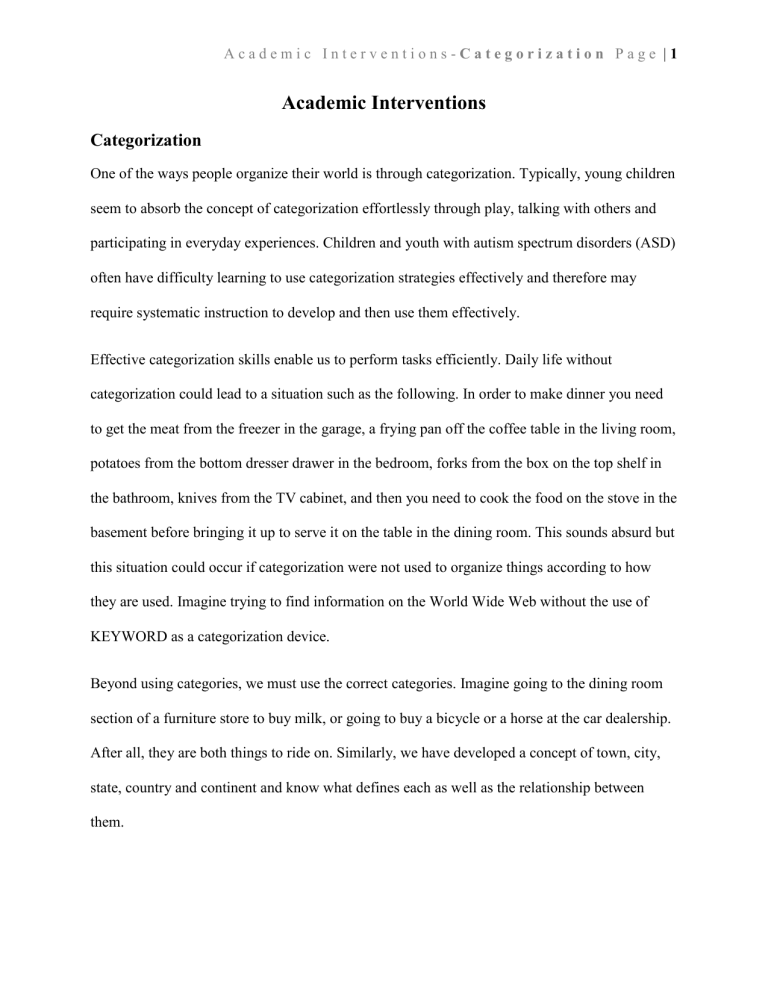
A c a d e m i c I n t e r v e n t i o n s C a t e g o r i z a t i o n P a g e | 1
Academic Interventions
Categorization
One of the ways people organize their world is through categorization. Typically, young children seem to absorb the concept of categorization effortlessly through play, talking with others and participating in everyday experiences. Children and youth with autism spectrum disorders (ASD) often have difficulty learning to use categorization strategies effectively and therefore may require systematic instruction to develop and then use them effectively.
Effective categorization skills enable us to perform tasks efficiently. Daily life without categorization could lead to a situation such as the following. In order to make dinner you need to get the meat from the freezer in the garage, a frying pan off the coffee table in the living room, potatoes from the bottom dresser drawer in the bedroom, forks from the box on the top shelf in the bathroom, knives from the TV cabinet, and then you need to cook the food on the stove in the basement before bringing it up to serve it on the table in the dining room. This sounds absurd but this situation could occur if categorization were not used to organize things according to how they are used. Imagine trying to find information on the World Wide Web without the use of
KEYWORD as a categorization device.
Beyond using categories, we must use the correct categories. Imagine going to the dining room section of a furniture store to buy milk, or going to buy a bicycle or a horse at the car dealership.
After all, they are both things to ride on. Similarly, we have developed a concept of town, city, state, country and continent and know what defines each as well as the relationship between them.
A c a d e m i c I n t e r v e n t i o n s C a t e g o r i z a t i o n P a g e | 2
Why Is Categorization So Important?
The ability to group things according to a common characteristic and then name that characteristic is a basic concept that helps children form a basis for structuring and organizing their world. When you systematically teach categorization strategies, you are not just teaching a single skill but a system for learning, problem solving and organizing, you are also teaching the foundation for processing, remembering and integrating new information. Many of us marvel at and even envy people who are always able to put their finger on an object or piece of information when needed because they know where to find it. This would not be possible without having developed complex organization strategies that include categorization.
Key Points:
Categorization helps students form a basis for structuring and organizing their world.
Categorization strategies can become a system for learning, problem solving and organizing.
Categorization is a foundation for processing, remembering and integrating new information.
How Do Most Children Learn to Categorize?
Matt is going for a walk in the neighborhood with his dad. He points to a cocker spaniel running after a frisbee and says, "Kitty." His dad connects him saying, "No, that’s a dog." Matt says,
"Dog." Further along on the walk Matt sees an Irish Setter. He immediately points to it and says,
"Dog." His dad responds, "Yes. That’s a big red dog." Matt is beginning to learn the category of
"dogs."
A c a d e m i c I n t e r v e n t i o n s C a t e g o r i z a t i o n P a g e | 3
Through a variety of experiences that include seeing and hearing others talk about dogs of different breeds, as well as being corrected when he uses a different word for a dog, Matt is learning what does and does not fit under the category of "dog." Although this seems very simple, when you consider all the skills Matt needs to have in order to reach this understanding.
It is indeed quite remarkable. For example, Matt needs to learn the common features of dogs, such as: fur, four legs, two ears, tail, two eyes, long nose, teeth, and tongue. But that is not enough, as obviously many other animals have those same features (cats, cow, horses, raccoons, etc.). Therefore, Matt must also learn what a dog is not. And then he must learn that there are many variations (color, size, shape, length of fur, size and shape of ears, differences in the sounds they make). Eventually, he will also learn there may be exceptions to the rules (no tail, pug nose).
Simultaneously, Matt will learn about many other categories of familiar things around him. He will learn that dogs, birds and fish all belong to a category called animals. He will learn that foods are something to eat, while cars, busses and bicycles are things people ride. Flowers, trees and grass are called plants, and plants and animals are living things. Rocks, water and rugs, on the other hand, are not living things. And further complicating matters, a wooden table, cotton shirt and paper are not living but made of things that were once alive.
Matt will learn that things can be grouped or categorized in many different ways. For instance, items can be grouped by what they look like, what they are made of or how they are used. For
Matt, the ability to grasp the concepts involved in understanding increasingly complex categorization skills develops so easily and naturally that his parents and others around him are unaware that they are teaching him an essential skill for organizing his world. He will continue
A c a d e m i c I n t e r v e n t i o n s C a t e g o r i z a t i o n P a g e | 4 to develop and refine his understanding and use of categorization in school and everyday experiences throughout his lifetime.
Key Points:
Most children learn categorization strategies incidentally through experience and interaction with others.
Categorization skills involve language learning.
Categorization strategies develop along a continuum from simple to complex.
Why Is Categorization So Difficult for Children and Youth with ASD?
Categorization can be very confusing to people with ASD. To many, it is a totally foreign, perplexing concept. Why is that?
Different Ways of Thinking
As a woman with very high-functioning autism, Temple Grandin says that she thinks "in pictures" whereas most typical people think in words. Words help people categorize. In Thinking in Pictures and Other Reports from my Life with Autism, Temple Grandin describes the way she thinks of dogs.
... my concept of dogs is ... linked to every dog I’ve ever known. It’s as if I have a card catalog of dogs I have seen, complete with pictures, which continually grows as I add more examples to my video library. If I think about Great Danes, the first memory that pops into my head is Dansk, the
Great Dane owned by the headmaster at my high school. The next Great Dane I visualize is
Helga, who was Dansk’s replacement. The next is my aunt’s dog in Arizona, and my final image
A c a d e m i c I n t e r v e n t i o n s C a t e g o r i z a t i o n P a g e | 5 comes from an advertisement for Fitwell seat covers that featured that kind of dog. My memories usually appear in my imagination in strict chronological order, and the images I visualize are always specific. There is no generic, generalized Great Dane.
(Grandin, 1995 p.#??)
Could you imagine how challenging it would be for most of us to have to go through a visual list in your mind when someone simply mentions the word "dog?"
Paying Attention
There are several things about paying attention that most of us take for granted. Even in infancy, most babies quickly learn to look at and listen to things that are (a) meaningful and important, (b) interesting and exciting, and (c) comforting and make them feel good. Typically developing babies learn to focus on people around them and on things that are happening in their environment. They learn to tune in to certain tones of voices and recognize their own names when they hear them. These babies react socially by looking at and listening to people and things, smiling, crying, laughing, cooing, moving or reaching toward something they find interesting and desirable. Even babies who are deaf, blind or in some way physically challenged pay attention to and interact with their surrounding world in a variety of ways.
By comparison, many children with ASD pay attention to things that most of us would find to be unimportant. A piece of string or the corner of a wall may interest a child with ASD for an hour.
A spinning wheel on a toy car may be far more fascinating than actually making the car go or joining in an activity in which others are playing with cars. When two or more people are able to show a mutual interest in something or somebody it is called joint attention. Joint attention also involves shifting attention from each other to an object or activity, and back again to each other.
A c a d e m i c I n t e r v e n t i o n s C a t e g o r i z a t i o n P a g e | 6
People with ASD often have great difficulty with joint attention, and frequently get "stuck" on the object or activity holding their attention.
Jamal, a preschool student with ASD, is seated at a table with two classmates for a silverware sorting game. Even though his teacher has explained the activity and his classmates have taken their turns to put their silverware in the proper section of the silverware tray, Jamal is focused on counting the tines of the forks. He has not paid attention to the others and he is "stuck" on what he is doing.
Jamal’s tendency to focus on less relevant features, like the tines of the forks instead of the actual activity, is known as overselectivity (Lovaas, Koegel, & Schreibman, 1979).
Joyce is very focused on colors. She groups and sequences objects by color at every opportunity.
For example, she eats colored cereal such as Fruit Loops in sequence by the colors of the rainbow. She eats all of the red, then orange, then yellow and so on!
While Joyce’s cereal eating can be a fun game, such instances of overselective attention can greatly interfere with other tasks involving categorization.
Abstract Concepts
Categorization involves abstract concepts. In other words, it involves concepts that are based on ideas and qualities, rather than just physical things. An abstract painting, for example, shows impressions rather than what objects or people actually look like. Often, a person with ASD has difficulty learning about abstract things and distinguishing between concrete and abstract.
Symbols such as traffic signs, conceptual figures using arrows, circles, squares, or triangles, are also abstract. As many people with ASD have good visual skills, some may learn and recognize
A c a d e m i c I n t e r v e n t i o n s C a t e g o r i z a t i o n P a g e | 7 visual symbols with little apparent difficulty. However, they may have trouble understanding the meaning of those symbols. Therefore, it is necessary to teach the meanings of icons or symbols that are used in categorization activities. Bock (1994, 1999) developed a categorization strategy to teach this skill to children and youth with ASD. Teaching individuals on the spectrum to categorize according to three different variables such as color, shape, and size, Bock reports that these categorization strategies have generalized to help children with ASD sort laundry, stock groceries, and use appropriate verb tenses.
Making Up Rules
Another reason categorization is so difficult for people with ASD is that many make up their own rules, strategies, or explanations. Studies have shown that many children across autism spectrum use idiosyncratic or stereotypic (habitual) strategies when learning. (Prior, 1979). Just as a superstitious baseball player may always wear a certain pair of socks or drive exactly the same route to the ball field, as if the outcome of the game depended on these routines, a child with ASD may have a strategy that has nothing to do with the task at hand. For example, silverware may be sorted by every third piece or by every piece that is facing diagonally on the table, or every piece that clinks a certain tone should be placed together. (You’ll notice that these are still categorized, but not by what is meaningful to most of us!) As these made-up rules are usually ineffective to the task at hand, it is important to directly teach the rules that a child must follow for success.
Key Points:
Words help people categorize. For those who think visually, categorization is very difficult.
A c a d e m i c I n t e r v e n t i o n s C a t e g o r i z a t i o n P a g e | 8
In order to categorize, individuals must be able to pay attention to relevant features. For those who focus too much, too little, or get stuck on certain details, categorization is very difficult.
Categorization involves abstract concepts based on ideas, qualities and symbols, and can be very difficult for "literal thinkers."
Categorization involves rules and patterns. For those who make up their own rules, categorization can be very difficult.
What Learning Strategies Do Children and Youth with ASD Have That Might
Help Them Learn Categorization?
We learn things using strategies, although we often do not notice when we use these. Each of us have our own learning style. What kinds of learning strategies do people with ASD use?
Visual Spatial
In her book, Do-Watch-Listen-Say: Social and Communication Intervention for Children with
Autism, Quill (2000) explains how children with autism learn.
... it is generally easier for them[children with autism] to process visual information that does not rapidly change. In contrast to fleeting visual auditory information, visuospatial stimuli (e.g., objects, pictures, graphics, written language) are fixed in space and time, and therefore, are often easier for the children to process. (p.?)
Visual cues and prompts help children with ASD learn categorization skills. Depending on the child’s age and ability, it is often helpful to start with more concrete cues, and move on to more
A c a d e m i c I n t e r v e n t i o n s C a t e g o r i z a t i o n P a g e | 9 abstract or symbolic cues as the child masters the information at the concrete level. When introducing new categorization activities, you might move from easy to more difficult in the following way:
actual item
model of the actual item
color photo
black and white drawing
So, if you’re sorting apples and oranges, start out with the actual fruit, then move on to toy fruit, then photos, and finally black and white drawings. Please note, however, that because students with ASD may differ from one another, this hierarchy may work for one child, but not another.
Haptic
Researchers use the term haptic modality to refer to an activity that can be physically touched and manipulated. Many children and youth with ASD react strongly to various textures. Quite a few are compelled to touch just about everything they see. Others seek out certain items to touch while avoiding others. In many cases, in order for an activity to have meaning, the child must touch it. We all learn a good deal about things if we feel the weight, texture, shape, and temperature of an item.
Meaningful Rules
Children and youth with ASD can be great rule followers, taking comfort in the predictability and concreteness of rules. All games have rules, whether it be a game of solitaire, a board game,
A c a d e m i c I n t e r v e n t i o n s C a t e g o r i z a t i o n P a g e | 10 or a basketball game. The rules for sorting laundry, for example, may be to sort by color (visual) and texture (haptic). We need to make sure that the rules are sensible and relate meaningfully to the activity. We wouldn’t have a rule, for example, to sort clothes based on what someone ate for breakfast that day!
Self-Talk
If you’ve ever watched the TV show
Who Wants to Be a Millionaire
, you’ll have seen examples of how talking to oneself can help a person get organized when trying to solve a problem.
Frequently, the contestants talk about the questions and possible answers before deciding what to do. Many individuals with ASD use self-talk in a less functional, repetitive manner. However, teaching children with ASD to use language to guide their thinking is an effective technique when working with categorization activities. Self-talk can help children organize their thoughts, rehearse the rules and expectations of the activity, and communicate to others (whether intentional or not) what they are thinking and the processes they are using to figure out how to solve a problem.
Key Points:
Visual cues and prompts help with categorization.
Physically manipulating and touching objects can make a categorization activity more meaningful.
Rules must be meaningful and relate to a categorization activity.
Self-talk can is a strategy that helps with organization in categorization activities.
A c a d e m i c I n t e r v e n t i o n s C a t e g o r i z a t i o n P a g e | 11
Assessing and Teaching Prerequisite Skills
The first step in deciding how to start teaching categorization is determining what skills the student already has. Careful observation of the student’s behavior in a variety of settings is a valuable way of determining whether the student has the prerequisite skills to begin training on categorization strategies. During this stage, it is also a good idea to gain information about how the student is already using categorization. Note the students’ organization strategies during daily routines as well as their choice of play and leisure activities and how they use preferred materials. These observations will serve as a guide in your decision on where and how to begin teaching.
Specific skills to assess when trying to determine a child’s categorization skills include:
Ability to discriminate between two objects
Ability to match identical objects
Ability to match identical pictures
Ability to conceptualize words
Ability to sort a group of objects into two identical sets (red bears, large wire paperclips)
Ability to sort a group of pictures into two identical sets (Cookie Monster, Big Bird)
Ability to sort a group of objects by one feature (small silver paperclips, large silver paperclips)
A c a d e m i c I n t e r v e n t i o n s C a t e g o r i z a t i o n P a g e | 12
Examples of Informal Assessment Through Observation
Visual discrimination : Johnaska often chose to take the memory cards from the shelf during playtime in her preschool program. Some cards had patterns and some did not. She would take the cards out of the box one at a time, looking at the pattern on the back of the card before placing it pattern side up on the floor, repeating this process until all the cards were on the floor.
Clearly, Johnaska demonstrated an interest in visual patterns and her ability to visually discriminate between pattern and no pattern.
Matching identical objects: Upon arriving at school Mohammad immediately went to the play area, found the two Fisher Price "little people" with brown hair and orange bodies and then carried them around, one in each hand. He appeared to have emerging skills in matching two identical objects among many kinds of toys. Interesting, Mohammad did not have an understanding of the spoken word "little people." In fact, he appeared to have few receptive language skills. As a result, systematic teaching of object labels became an important part of his program.
Matching identical pictures : Corey was a fan of Disney videos and could name all the characters. Lion King being his current favorite, one of his favorite activities was to use the small pictures of the Lion King characters to match the pictures of the characters in the Lion King book. Corey successfully used the skill of visually discriminating and matching identical pictures.
Sorting objects into two identical sets: Yannie’s chore after snack at school was to stack chairs, put dishes in the sink and throw away any paper that might be lying on the floor. In this situation
A c a d e m i c I n t e r v e n t i o n s C a t e g o r i z a t i o n P a g e | 13
Yannie demonstrated his ability to sort objects by location within a learned routine (stack chairs, dishes in sink, throwaway paper).
Sorting objects by one feature: One of Adam’s favorite snacks was Fruit Loops. When given a small bowl of the multi-colored cereal, he would pick out and eat all the yellow ones first, then the orange, red, purple, blue and finally the green cereal pieces. This activity revealed that Adam was able to sort cereal by color.
In each of these cases, one example of the skill was given that identifies that concept as an emerging skill for the student. As an educator, you need to expand on the skill using a variety of materials and concepts and as we as broaden the contexts or environments in which the student can use the skill. In all cases, using simple language to label the concepts being taught is critical.
There are a number of ways to expand on emerging skills.
1. Introduce similar materials within the context of the activity where the child is already demonstrating the skill.
Examples:
Visual discrimination - Introduce a new set of cards with a different ??to Johnaska.
Matching identical pictures – Have Corey do the same matching activity with the Little
Mermaid book.
2. Incorporate use of the skill within the context of a functional routine.
A c a d e m i c I n t e r v e n t i o n s C a t e g o r i z a t i o n P a g e | 14
Examples:
Sorting objects into two identical sets – Have Yannie put towels in the laundry basket and shoes on the rack in the closet or sort the mail by putting the envelopes in the mail basket and flyers in the recycle box.
Sorting objects by one feature - When it was time to clean up after table time, ask Adam to collect first all the yellow crayons, then orange and so on.
3. Use structured work tasks to build on emerging skills
Examples:
Visual discrimination – patterned cards in the 12 sections of the tray from the Memory game with a small box holding 12 more cards attached to the left side of the tray and physically guide Johnaska to take a card from the box and place it in one of the sections in the tray. After she is guided to place three cards, she continues on her own until all the cards are placed in the tray. Once Johnaska has learned to use the tray to match patterned cards, new cards can be introduced to build on her visual discrimination skills.
Key Points:
It is important to teach prerequisite skills before planning a lesson.
Gain information on where to start by observing the student during preferred and routine activities.
Teach emerging skills in a variety of situations and with a variety of materials to promote generalization across contexts.
A c a d e m i c I n t e r v e n t i o n s C a t e g o r i z a t i o n P a g e | 15
Teach language related to the skill being taught.
Teaching Categorization
Structured teaching developed by Division TEACCH from the University of North Carolina
(Mesibov, Schopler, & Hearsey, 1994) can be a valuable tool for teaching sorting and categorization skills. Using this teaching strategy involves designing and making work tasks that provide clear visual information about what the student is supposed to do. This strategy answers the following questions for the student:
What am I supposed to do?
How much am I supposed to do?
How do I know when I’m done?
What do I do next?
Following informal assessment of a student’s skill level, design tasks to build on emerging skills to guide the student toward independence. A structured work task can be a valuable tool for teaching sorting and categorization because once learned, the familiarity and predictability of the task enable the student to focus on the new concepts being taught.
Designing Work Tasks for Beginning Categorization
Once you have determined the student’s current level of understanding and use of visual discrimination, matching, sorting and categorization through observation and informal assessment, you are ready to develop these skills into strategies.
Sorting
Sorting can be done with objects, symbols, pictures or even written words depending on the level of the student. It is best to begin at the level where the student demonstrates emerging skills to ensure a high rate of success. Because students with ASD are typically visual learners and physical features are often the first attribute children focus on, it is usually helpful to begin with two things that have clear and simple distinctive features. For a beginner such as Adam (who eats his cereal by color), a work task teaching two-way sort by color might be used. The following work task constructed for Adam incorporates this concept.
Two identical clear containers were attached side to side on the right side of a small tray. The lid of each container was cut out in a square shape and a black magic marker was used to outline the edges of the cut-out. A red block was glued to the front of one container and a yellow block was glued to the front of the other. On the left side of the tray was a small box containing six red blocks and six yellow blocks. Adam was taught to sort the blocks in the following manner. Adam transitioned to the work area using his symbol schedule. His teacher accompanied him and guided him to take the sorting task from the shelf and put it on the table. She then physically guided him to pick up a yellow block from the box and hold it next to the yellow block glued to the container. She then said "yellow" and guided him to put the block through the hole in the top
A c a d e m i c I n t e r v e n t i o n s C a t e g o r i z a t i o n P a g e | 16 of the container. She used the same process with a red block. Adam’s teacher faded her support until after six trials Adam began to take a block, match it and put it in the correct container independently. When all the blocks were put in the correct containers, the teacher guided Adam to put the task back on the shelf and Adam went to check his schedule for the next activity.
In this example, a simple sorting task was used to teach categorization by color. The task was designed to provide clear visual information as to what was to be done (containers labeled with yellow and red blocks). There was a definite end point (when all the blocks were in a labeled container). Notice Adam’s teacher used spoken language to emphasize the salient feature
(yellow, red) and used the opportunity to teach receptive language by pairing the spoken word with the visual cue of holding the blocks side by side.
The following day, Adam was able to complete the entire process independently. The teacher changed the task to require sorting blue and orange blocks, then green and purple and so on, until he was able to independently sort any combination of colored blocks into two groups. Adam was soon able to use this system to learn to sort a variety of groups of objects into two identical sets
(big red bears/small red bears; pictures of Simba/Pictures of Tarzan; yellow pencils/green erasers; green colored links/small red beads, etc.).
In order to provide enough repetition and practice, five to eight items of each set should be used.
It is helpful to consider the individual students’ interests when choosing items to sort, especially in the beginning. If the student has difficulty learning this type of task, simplify the task by choosing sets of objects of different shapes (i.e., square blocks and cylinders). Then label the containers and cut a square hole in the lid of the container labeled blocks and a round hole in the lid of the container labeled cylinders.
Increasing the number of sets required for the task can expand on this type of sorting task. For instance, sets of three different-colored objects could be used or paperclips, erasers and rubber bands could be sorted into three sets.
Reviewing the task with the student upon completion offers a great opportunity to reinforce the language concepts central to the task.
Categorization
Once a student is able to sort a variety of objects or pictures, you can use the same types of systems and tasks to begin to teach categorization. Sorting identical objects or pictures can be done by visual discrimination of physical features. Categorization requires learning the underlying concept that describes the relationship between the items in the category and involves the use of language.
Although students often need tangible, visual cues when learning categorization strategies, it is important to also model the use of language to describe the salient features that define the category being learned. Some examples of categorization ideas for early language users include:
Color
A c a d e m i c I n t e r v e n t i o n s C a t e g o r i z a t i o n P a g e | 17
Clean/Dirty
Fast/Slow
Big/Little
Old/New
Broken/Fixed
Hot/Cold
One/Many
People (boy, girl, man, woman)
Animals (dogs of different breeds, land animals, birds, fish, farm animals, wild animal)
Function (wears, eat, drink, write with, ride in, play with)
Shape (round, square, oval, rectangle, etc.)
Location (indoors/outdoors; grocery Store, hardware Store, school, home)
Location within rooms at home (bedroom, kitchen, garage, bathroom, family room)
Systematic Instruction for Teaching Categorization Strategies
A procedure of direct systematic instruction has been used successfully to teach students with
ASD to use categorization strategies and to generalize the strategies to novel situations (Bock,
1994, 1999). Utilizing the learning strengths of students with ASD, the system is designed to minimize irrelevant details and highlight salient features. It begins by requiring a yes/no judgment of a given item belonging to a group by only one feature, then two, then three features.
Procedure for Teaching Categorization by One Feature
Begin by selecting one feature item to categorize (in this example, shape). Select a label belonging to the category (circle). Prepare a group of items that do and do not match the label
(circles, squares, triangles). Teach the student to take each item, determine whether it does or does not match the label and place it on a grid under the label if it matches or in a container placed on the right, if it does not match. Initial teaching procedures include physical guidance and verbal modeling of the yes/no judgments. These prompts are faded as the student moves toward independence at the task. The student is reinforced for time on task. Training continues until the student is independently able to categorize several different features.
Procedure for Teaching Categorization by Two Features
The same procedure used to teach categorization by one feature is used to teach categorization by two features. The first feature (in this example, circle) is labeled. The second feature (in this example, the colors red, blue and yellow) is added as labels. The student’s task is to determine if each of the items matches the features labeled on the worksheet and place it in the appropriate place. If the item does not "fit" the requirements, it is placed in the container on the right.
Procedure for Teaching Categorization by Three Features
The next step is to add an additional feature label (in this example, the numbers 1, 2, and 3 to shape and color). The student’s task is now to select an item and determine if it matches the
A c a d e m i c I n t e r v e n t i o n s C a t e g o r i z a t i o n P a g e | 18 labeled categories and, if so, where to place it according to its features (shape, color and number). This teaching procedure directly teaches students:
How to use symbolic stimuli
Effective and functional rules
How to learn, problem solve and complete tasks independently
Resulted in spontaneous generalization in most cases.
In preparing to teach a categorization task it is helpful to:
1.
Carefully consider and determine the steps involved
2.
Be aware of how you intend to fade prompts
3.
Identify reinforcers for the student on completion of the task
4.
Determine the language to be used in teaching categorization concepts
File Folder Activities for Categorization
Expanding on the example of a work task described in the sorting activities, folder games can be used to provide initial training for categorization, individual practice or a structured learning activity with a peer partner.
A category folder game can be easily made by using a pocket folder. At the top of each side of the folder is a space to label the category for that side (i.e., one side could be animals that live in the ocean, the other side animals that live on land). On the front of the folder is a pocket containing a set of pictures or written words of animals that can be categorized according to the designated feature. For initial teaching, the teacher models taking a picture, using self-talk to model her thinking process, and then placing the picture on the correct side of the file folder. In this example, the teacher might take a picture of a whale and say, "A whale is an animal that lives in the ocean." Once the student understands and is able to complete the task, having the student teach it to another student can reinforce the concepts. This type of folder task may also be done with a peer partner as a game to facilitate social interaction skills.
It is important to keep in mind that the categorization concepts taught during direct teaching must be generalized to a variety of settings and activities.
Using Categorization Strategies to Teach Functional Skills
Categorization strategies can be taught through functional activities. The teaching strategies discussed previously can be applied to any functional skill. The abilities of the child or youth with ASD should be the determining factor in deciding which strategy is used.
Functional activities involving categorization include:
1.
Clearing the table after a meal
2.
Putting toys away
3.
Emptying the dishwasher
A c a d e m i c I n t e r v e n t i o n s C a t e g o r i z a t i o n P a g e | 19
4.
Unpacking groceries
5.
Sorting laundry
6.
Making a grocery list /going shopping
7.
Making a snack
8.
Setting the table
Labeling cupboards, shelves, and containers with either pictures or written words is a useful strategy, not only to teach the skill but to serve as a visual cue to promote independence.
Using Categorization Strategies in the Content Areas
Categorization strategies can also be taught through group discussion if students have the necessary language skills. For instance, category labels could be identified and written on the chalkboard and students could be asked to generate things that belong in the category identified and then list ideas under the category label. This activity can be used for just about any academic subject. For example, for English class, parts of speech might be used
(nouns/verbs/prepositions). In geography students might be asked to categorize countries by continents. In math class odd and even numbers or whole numbers vs. fractions could be categorized. Another idea is to plan an activity where students are asked to list five things that go together in some way then exchange lists with a partner. The partner’s task is to determine the commonality among the items and determine the category to which they belong.
Key Points:
Visual cues are useful tool when teaching categorization.
Categorization activities can be used for initial teaching and to provide repetition and
practice.
Categorization strategies are an integral part of learning at all ages and levels of development.
A c a d e m i c I n t e r v e n t i o n s C a t e g o r i z a t i o n P a g e | 20
Quiz
1. Categorization is easy for all children and youth with autism.
True
False
2. Which of the following is NOT an example of an activity that uses categorization?
A. laundry sorting
B. getting dressed to play in the snow
C. shopping for groceries
D. rocking in a rocking chair
3. Categorization activities may take place in which of the following locations?
A. home
B. school
C. community
D. all of the above
4. People learn categorization best if they make up rules.
True
False
5. Categorization activities should never have more than one feature at a time.
A c a d e m i c I n t e r v e n t i o n s C a t e g o r i z a t i o n P a g e | 21
True
False
6. Which of the following skills are used in categorization?
A. matching
B. sorting
C. visual discrimination
D. all of the above
E. none of the above
7. When categorizing, self-talk should be discouraged as it is distracting.
True
False
8. An example of a haptic modality is:
A. touching and manipulating
B. looking
C. listening
D. all of the above
9. Categorization strategies should only be taught in isolation.
True
False


